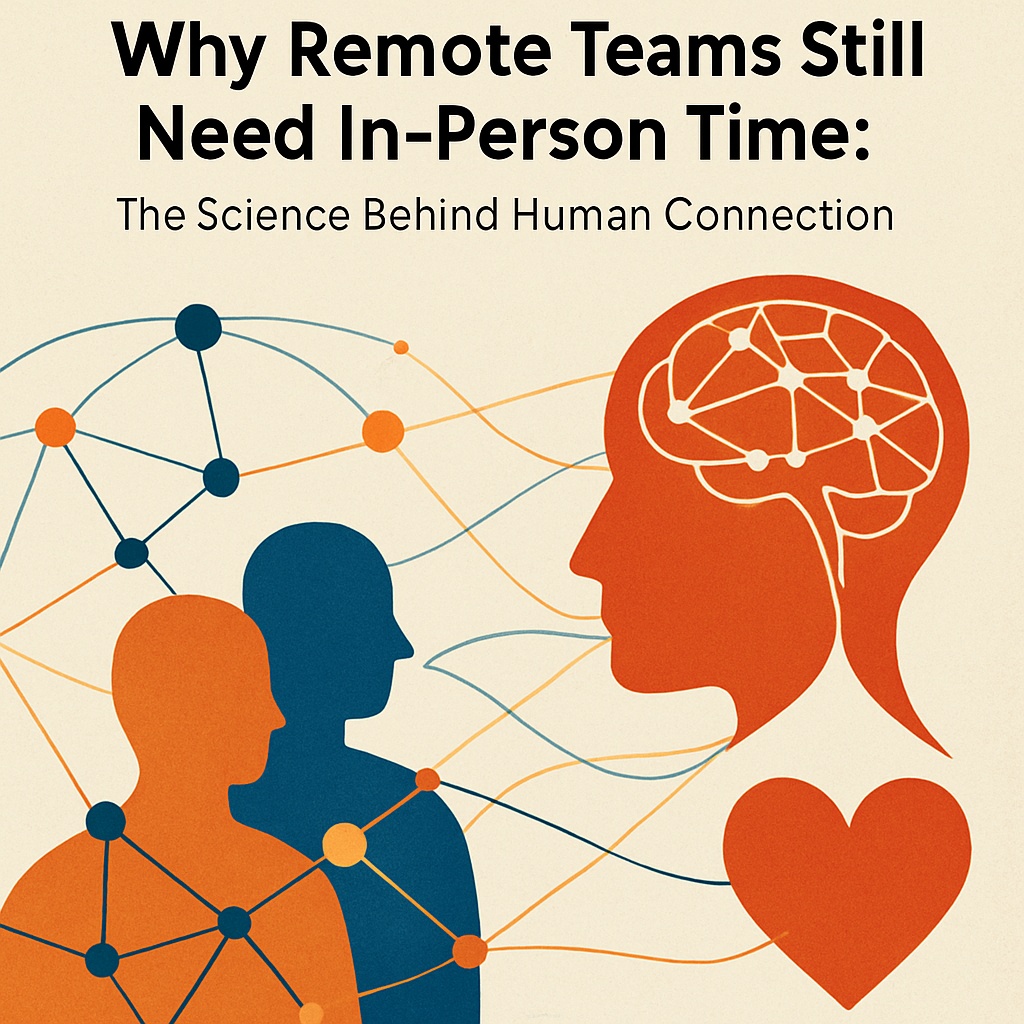Introduction: In the wake of the pandemic, remote and hybrid work have become the norm for many organizations. As a former HR professional and now the CEO of a travel tech company, I’ve witnessed both the benefits of remote work and its hidden costs. Productivity may remain high in a distributed team, and talent pools have widened, but something fundamental is often missing when colleagues never meet face-to-face. Humans are social creatures wired for connection, and even the best video conferencing tools can’t fully replicate the chemistry that sparks when people share the same physical space. Companies that eagerly embraced remote work are now grappling with this reality. Many have called employees back to the office—at least part-time—not out of sheer nostalgia, but because in-person interaction fills critical gaps in trust, empathy, and innovation that virtual work struggles to bridge. The emerging consensus, backed by behavioral science and organizational research, is that remote teams still need in-person time. Occasional face-to-face engagement isn’t a luxury or a mere social perk; it’s essential for building the human connections that make teams greater than the sum of their parts.
Trust, Empathy, and the Human Touch
One of the first casualties of an all-remote environment is often the depth of trust and empathy among team members. When colleagues only know each other through screens and text, relationships tend to stay transactional and surface-level. In fact, research from Deloitte suggests that a staggering proportion of workers feel a void in their workplace relationships: about 80% of people report lacking close, meaningful bonds with their co-workers, which in turn harms their engagement and effectiveness on the job. This isn’t just a “feel-good” issue—trust-based relationships have tangible performance implications. Studies have shown that authentic connections at work boost job satisfaction, collaboration, and even productivity and retention. Put simply, when people genuinely trust and understand each other, they perform better as a team.
Fostering that kind of trust and understanding is immeasurably easier when teams get occasional face-to-face time. Physical presence allows for the rich communication that remote channels often lack. In person, communication isn’t limited to the words we speak or type; we pick up subtle non-verbal cues — the quick reassuring smile, the nod of agreement, the leaning forward in excitement — that are hard to perceive on a video call. These small moments of eye contact and body language help colleagues develop empathy and read each other’s moods and intentions. As one leadership observation put it, video calls may be great for getting tasks done, but they “miss the subtle nuances of non-verbal communication: the quick smile of understanding, the furrowed brow of concentration” – the very cues that “help build trust [and] foster empathy” in a team. Brain scientists would add that face-to-face interaction triggers neurological responses (like releases of oxytocin, the so-called “trust hormone”) that simply aren’t as active in virtual settings. While Zoom and Slack are efficient, they filter out the human elements of tone, touch, and presence that bond people together. It’s no surprise, then, that purely virtual teams often struggle to develop the same camaraderie; over time, a distance-based disconnect can erode morale and loyalty. By contrast, a bit of in-person interaction goes a long way to strengthen social ties. Grabbing coffee together or chatting before a meeting allows colleagues to open up, share a laugh, and see each other as multi-dimensional humans rather than abstract usernames on a screen. These informal moments create what psychologists call “vulnerability loops,” where showing a little humanity begets trust in return. Such interactions are the foundation of psychological safety on teams. Indeed, management experts warn that if hybrid teams split into a core of in-office people versus always-remote individuals, a “two-class system” can emerge, corroding trust between those who bond in person and those left out. Smart leaders thus make a point to regularly bring everyone together so that trust is continually reinforced in person rather than left to dwindle across digital divides.
The importance of in-person connection also extends to empathy and mental well-being. Fully remote employees often report feeling isolated or “invisible” in their organizations. Without hallway chats or lunch outings, it’s harder to sense a colleague’s struggles or to notice the stress behind someone’s stiff email reply. Empathy can fade when interactions are reduced to scheduled Zoom calls that rarely stray from task lists. A recent Deloitte study notes that our “always on” remote-work culture is increasing isolation and burnout, negatively impacting workers’ happiness and engagement. In-person time acts as an antidote to this loneliness. When teammates meet face-to-face, even infrequently, it humanizes the workforce. We remember that our co-workers are people with families, jokes, and feelings – not just avatars who produce work product. That rekindling of human empathy pays off back on the virtual days: after sharing a meal or a handshake, colleagues tend to give each other more benefit of the doubt and communicate with greater patience and care. No wonder an Harvard Business Review analysis found that companies cultivating a strong sense of connection among employees outperformed peers by roughly 20%. Empathy isn’t just a nice-to-have in the workplace; it’s a driver of effective teamwork and loyalty. And while you can certainly practice empathy remotely, it flowers more naturally through real, face-to-face interactions where genuine understanding can take root.
It’s also worth noting that professional growth and “soft skills” development are accelerated by in-person experience. Younger employees in particular often learn by observing colleagues and receiving in-the-moment feedback – opportunities that are scarce in a remote vacuum. As one expert put it in HBR, don’t “overlook the importance of spending some time in-person with your colleagues”; such face time is essential for honing communication, emotional intelligence, and other soft skills that propel career development. A quick coffee chat with a mentor or an impromptu debrief after a client meeting in the office can impart lessons that no amount of instant messaging can replace. In summary, trust, empathy, and interpersonal skills form the social glue of an organization, and nothing cements that glue quite like meeting in person. Remote teams ignore this human element at their peril: without periodic in-person bonding, team spirit and trust can slowly evaporate, undermining the very efficiency gains that remote work aims to achieve.
The Innovative Spark of Proximity
Beyond morale and trust, there’s another realm where physical togetherness shows its power: innovation. Creativity in organizations often thrives on serendipity and spontaneity — the unplanned hallway conversation, the energetic brainstorm at a whiteboard, the exchange of half-formed ideas that suddenly click into a breakthrough. In a fully remote setup, those sparks are harder to ignite. Zoom meetings tend to be agenda-driven and transactional; people log off once objectives are met, with few lingering chats. Chance encounters virtually are essentially nonexistent (no one “bumps into” a colleague on Microsoft Teams the way they might in a cafeteria). As a result, remote teams can become efficient at execution but struggle to replicate the creative combustion that happens when everyone’s in the same room.
There is mounting scientific evidence that face-to-face interaction fuels creativity and innovation in ways that virtual communication cannot. A notable Stanford study in 2022 examined idea generation in pairs of people working either in person or via videoconference. The findings were striking: the face-to-face pairs produced about 15–20% more ideas than the Zoom pairs, and their ideas spanned a wider, more diverse range of topics. By contrast, those limited to the screen not only came up with fewer ideas, but also tended to focus on a narrower set of possibilities, essentially incurring what the researchers called a “double penalty” for virtual brainstorming. The lead author, Stanford Professor Jonathan Levav, didn’t mince words about the implications: “If we want to generate better ideas, then we need to get people back to the office.” In-person collaboration appears to unleash a different cognitive energy – perhaps the buzz of social presence stimulates more free-flowing thought, or maybe being able to physically point at a shared diagram or prototype helps teams build on each other’s ideas more fluidly. Anyone who has participated in a lively, in-person brainstorming session can attest to the contagious creativity that fills the room. The laughter, the rapid-fire riffs, the encouraging nods – these intangible dynamics propel people to think bolder and bounce off one another’s energy. Those dynamics are muted on a videoconference where communication is one speaker at a time and everyone’s in little boxes. It’s no wonder that my own teams have often made breakthrough progress during offsite retreats or all-hands meetings. Time and again, I’ve seen a problem that stumped us for weeks over email suddenly get solved in an afternoon at a real whiteboard, fueled by the excitement and focus of being together. The science validates these anecdotes: proximity turbocharges collective creativity.
Innovation doesn’t only come from formal brainstorming; it also arises from casual knowledge-sharing and “eureka” moments that occur in unplanned encounters. Here, physical offices (or any shared physical venues) have a clear edge. A new study out of MIT Sloan quantified what is lost when those coffee machine chats and corridor conversations disappear. The researchers looked at data from Silicon Valley companies and found that when people stopped bumping into each other in person, the flow of new ideas between firms measurably dried up. Specifically, they tracked “knowledge spillovers” by analyzing patent citations as a proxy for innovation. The results were telling: reducing face-to-face meetings by a quarter was associated with about an 8% drop in cross-company patent citations, and cutting half of in-person interactions led to nearly a 12% drop in such knowledge flows. In other words, when fewer people mingle in the real world, fewer novel ideas cross-pollinate into inventions and new solutions. The authors attribute this to the loss of serendipitous encounters – those random chats with an acquaintance at a coffee shop or the impromptu brainstorming with a former colleague you ran into by chance. These informal exchanges often spark connections or collaborations that would never have been scheduled in a Zoom meeting. Innovation has a social component: networks of trust and familiarity make people more willing to share nascent ideas or pass along insights. Remote work, for all its benefits, can silo people into scheduled interactions and known contacts, starving the broader ecosystem of those happy accidents that drive innovation forward. As one McKinsey report bluntly summarized, certain kinds of collaboration and connectivity are simply “less effectively done virtually” – and brainstorming creative new solutions is a prime example.
To be clear, this is not to say that remote work kills innovation or that great ideas can’t emerge online. Digital collaboration tools have enabled global brainstorming and asynchronous creativity, and virtual work can even increase some forms of diversity in idea inputs. However, the weight of evidence indicates that physical presence amplifies innovative output. Teams that periodically come together to workshop ideas, hash out problems on a physical whiteboard, or tinker side-by-side on a prototype tend to experience a creative momentum that’s hard to achieve remotely. There’s a reason tech giants and startups alike invest in bringing employees to innovation hubs or offsites: proximity builds trust and enthusiasm, which in turn lubricates the free exchange of bold ideas. History’s great creative collaborations – from the Wright brothers to the founding teams of companies like Apple – usually involved people working intensely in person, feeding off each other’s energy. While our digital tools have advanced, our brains remain decidedly analog in how they forge creative connections. When you put bright people in a room, ideas ping-pong faster and an innovative “group flow” can emerge. Remote teams, therefore, ignore in-person creative sessions at their own risk. Even a few days of face-to-face brainstorming every quarter can rejuvenate a team’s innovative capacity and align everyone around new directions that emails and Slack threads would never have uncovered.
Culture, Mentorship, and the Power of Social Capital
In addition to trust and innovation, an organization’s culture and collective knowledge thrive on real human interaction. Company culture isn’t just articulated in mission statements or Slack emojis; it’s lived and transmitted through shared experiences. When people gather in person, they’re immersed in the tacit norms and values of the group – picking up on how colleagues interact, how leaders listen, and “how things really get done around here.” New employees, especially, gain a sense of belonging and learning through osmosis in an office environment or during in-person team events. That sense of belonging is critical. Social psychology reminds us that humans have a fundamental need to belong to a community, and workplaces that fulfill that need see higher commitment and lower turnover. It’s challenging to cultivate true belonging over a fully remote medium; video happy hours and virtual team trivia can only go so far. People bond faster through shared physical experiences – whether it’s laughing together during a team lunch, solving a problem shoulder-to-shoulder, or even commiserating about the bad coffee in the conference room. These little shared moments accumulate into an emotional connection to the team and company. “Humans are not designed to be alone,” as one analyst wrote; organizations that create genuine community have employees who stick around for years. In-person time is like the glue that holds the cultural fabric together, ensuring remote work doesn’t fray it entirely.
Another often overlooked aspect is mentorship and informal learning, which flourish with face-to-face contact. Early-career professionals benefit enormously from being around more seasoned colleagues – overhearing how they handle a tough client call, or getting pulled into an impromptu discussion after a meeting to explain the rationale behind a decision. In a remote setting, these spontaneous teaching moments are rare. Senior employees are less likely to notice when a junior team member is struggling or to offer on-the-spot advice when all interactions must be intentional and scheduled. Physical proximity, however, naturally creates opportunities for coaching and knowledge transfer. A 2023 study entitled “The Power of Proximity” underscored this: when engineers worked in the same building as their teammates, they received significantly more feedback and mentorship than those working apart. In fact, sitting together led to 22% more feedback interactions for engineers, an advantage that largely vanished when offices went fully remote. The same study found that women, in particular, both provided and received more mentorship when they were co-located with colleagues. Proximity, it turns out, was boosting human capital development—even if it meant some extra chat time that might modestly reduce individual “productivity” in the very short term. Over the long haul, that learning and networking translate into faster skill growth and career advancement. McKinsey’s research similarly emphasizes that activities like mentorship, coaching, and apprenticeship-style skill building are much harder in pure virtual mode. For organizations, this means the next generation of leaders may not develop as robustly if they never spend time in the same room as their mentors. As a former HR leader, I’ve seen how quickly rising talent can blossom after a few intense weeks collaborating on-site with experienced peers – their confidence, know-how, and engagement all leap upward. No amount of online training modules can fully replicate that effect.
In-person gatherings also reinforce organizational values and social norms in a way that emails cannot. Think of the new hire who joins a company remotely: it might take months for them to grasp the unwritten rules and cultural nuances. But invite that new hire to headquarters for a week, and they’ll likely absorb volumes of context – from how candidly people speak in meetings to whether it’s acceptable to ask questions of senior leaders. Those lessons translate into better communication and fewer misunderstandings later. It’s much easier to feel aligned with a company’s mission after you’ve felt the energy of an all-hands rally or shared a celebratory toast with colleagues after hitting a milestone. Culture is a contact sport; it’s built in person. Of course, hybrid and remote teams can have strong cultures too, but they often stem from prior in-person foundations or deliberate efforts to simulate in-person-like intimacy (through offsites, webcams on, etc.). Deloitte’s human capital experts put it succinctly: as technology enables more virtual work, leaders must “cultivate a culture of strong relationships” intentionally. Part of that cultivation means knowing when to turn off the screen and convene in person. Whether it’s an annual retreat, a quarterly planning session, or just a monthly team lunch, these touchpoints refresh the shared identity and social capital of the group. They create memories and inside jokes, strengthen friendships, and remind everyone why they do the work beyond just the paycheck. Especially in times of change or crisis, face-to-face meetings can rally the troops and build the trust needed to weather storms together.
Finally, we should recognize that distance can breed miscommunication if not counteracted. A classic finding in organizational behavior, known as the Allen Curve, showed that people who sit near each other communicate far more frequently than those farther apart – in fact, communication frequency drops off exponentially as distance increases. Thomas Allen’s research at MIT found we’re four times more likely to regularly interact with a colleague just 6 feet (2 meters) away than one 60 feet (20 meters) away, and that we “almost never communicate” with coworkers on another floor or building. Consider what that implies for remote work: if two people in the same building but on different floors rarely talk, how much harder is it for fully remote colleagues to reach out informally? It takes far more deliberate effort to maintain connections at a distance. Without proactive measures, remote team members can become siloed, with information and ideas not circulating freely. Important context might stay locked in private chat threads, and misunderstandings can fester because clarifying conversations don’t happen in passing. In-person time serves as a reset button for these dynamics. It nudges people to talk more, share more, and resolve ambiguity on the spot. Hallway conversations and overheard remarks in the office actually play a role in aligning understanding across a team. When remote colleagues meet, even briefly, it strengthens the weak ties and cross-team connections that keep information flowing. That’s why many fully distributed companies still budget for periodic offsites: they know those few days of high-bandwidth, high-trust communication will help prevent silos and disconnects in the months of remote work that follow. In essence, in-person time replenishes the reservoir of social capital and context that remote work gradually drains.
Conclusion: As we navigate the future of work, the goal is not to return to the office five days a week out of habit or managerial mistrust. Rather, it’s to deliberately combine the best of remote efficiency with the irreplaceable benefits of in-person interaction. The question is not remote or office? – it’s when and why should we come together? The research is increasingly clear on the why: to build trust, to spark innovation, to nurture culture, and to invest in our people’s growth and well-being. Yes, remote work offers flexibility and focus, but face-to-face time provides meaning and connection. As one McKinsey analysis noted, a primary reason to gather in person is to do those things that remote work handles poorly – the collaborative, creative, connective activities that energize organizations. In my experience, it’s during those in-person sessions that teams transcend mere coordination and achieve true synergy. After all, companies are more than just collections of tasks; they are communities of people. And people, with our social brains and hearts, need real human contact to fully trust, understand, and inspire each other.Leaders of remote and hybrid teams should therefore treat in-person gatherings not as an old-fashioned inconvenience, but as a strategic investment in the team’s social fabric. That might mean flying everyone in for a yearly summit, organizing quarterly team-building days, or simply encouraging local co-workers to meet up periodically. Such occasions create the “shared purpose” and social bonds that define high-performing teams. They also remind us that behind every Slack message or email is a living, breathing colleague. In-person time reintroduces the human element that turns a group of remote workers into a true team. The science behind human connection is telling us that presence matters – that despite all our technology, we haven’t outgrown our evolutionary need for physical togetherness. Trust, empathy, innovation, culture: these pillars of organizational success all have a profoundly human core. So as we embrace the efficiencies of remote work, let’s also remember to gather around the proverbial campfire now and then. Whether to brainstorm a bold new idea or to simply break bread and laugh together, there is no substitute for in-person connection. It is, ultimately, what makes work feel meaningful and what enables teams to achieve more than the individuals ever could alone. The companies that recognize this – that find the right balance between virtual and face-to-face – will cultivate the trust, creativity, and camaraderie needed to thrive in the hybrid era. The office of the future may not be an everyday destination, but it will remain an essential one, because when human beings come together, something special happens – the kind of alchemy that turns work into a shared adventure and ideas into world-changing innovations.
Sources:
- Harvard Business Review – Schinoff, B. et al. (2024). Research: How WFH Can Actually Strengthen Bonds Between Coworkers. (cited for context on remote work trends).
- Harvard Business Review – Knight, R. (2024). How to Improve Your Soft Skills as a Remote Worker. (cited on importance of in-person for soft skills)Source .
- Deloitte Insights – Fisher, J. & Phillips, A. (2021). Work Better Together: Why Workplace Relationships Matter. (cited for statistics on workplace relationships and remote-work effects) Source.
- McKinsey & Company (2023). Creating a Return-to-Office Policy That Works. (cited on types of work less effective virtually, e.g. collaboration and culture building)Source.
- MIT Sloan School of Management (2022). New Study Quantifies the Impact of Face-to-Face Interactions on Innovation. (cited for data on reduced innovation/patenting with less face time)Source .
- Stanford Graduate School of Business – Levav, J. et al. (2022). Research on remote vs. in-person idea generation (cited via podcast transcript for creativity findings)Source.
- Rita McGrath (2023). “Remembering the Allen Curve and Why It Matters.” (cited for communication drop-off with distance, the Allen Curve) Source.
- LinkedIn – Walsh, T. (2024). “How Human Connection Ignites Innovation in a Remote Work World.” (cited for non-verbal cues in trust and HBR connection statistic) Source.




